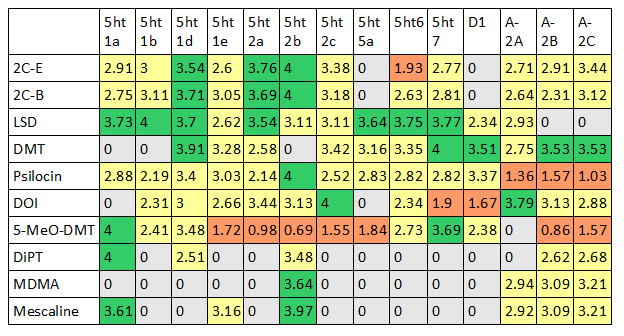serotonin2A
Bluelighter
- Joined
- Sep 13, 2014
- Messages
- 1,354
I'm not sure what you're trying to say. *I* am saying that these are some of the differences that I have experienced between the 2 drugs, but by all means not all of the differences. I respectfully disagree; to me the time course of effects is a quantitative difference.
By definition, time course cannot be a qualitative difference -- it is a quantitative difference, just like intensity. If you take a lower dose of a drug, or inject it, that will also change the time course. But that doesn't necessarily mean you are having a qualitatively different experience.
And of course mushrooms are not the same as Psilocybin; I never said otherwise. And respectfully, yes I am doing this comparison with mushrooms because (wait for it) I am comparing mushrooms; I didn't mention Psilocin, Psilocybin, 4-AcO-DMT or any other specific chemical. The effect I get from mushrooms is different than the effect I get from 1P-LSD, I could tell them apart easily.
I think you are completely missing the point of what I am saying. I'm not saying that it isn't possible to perceive differences between different hallucinogens. Clearly people perceive differences. What I am saying is that (1) the differences that people perceive are not due to specific, pharmacological differences between the drugs. And (2) that the differences that you may perceive are subjective, meaning that they are not inherent properties of the drugs.
Psilocybin mushrooms contain all kinds of alkaloids in addition to psilocybin and psilocin that produce GI side-effects, so of course you may be getting somewhat different effects from mushrooms vs. 1P-LSD. But along those lines, if you had mushrooms that contained 1P-LSD, they very possibly might produce different effects then 1P-LSD on blotter paper.
You can't disprove that.
It isn't necessary for me to prove it. You are the one making the claim that you can do something that you have never actually tried to do. Because when people have tried to do what you are claiming you can do, they have found it very difficult, so it's up to you to to prove that those published studies are wrong.
Yes, I've seen things on mushrooms that I haven't on 1P-LSD. Again, not sure what you're trying to say.
I'm trying to say that the effects of hallucinogens cannot be separated from set and setting. So if you eat a mushroom, it is going to markedly influence how you perceive the experience. Some people will have different experiences depending pn whether they ingest 15 mg of psilocybin in the form of mushrooms vs. as pure psilocybin in a pill.
Maybe you misinterpreted my saying 'they just feel different' ? I'm saying that in the same sense that I would say 'I just don't like pancakes' because I don't.
Tom
Not liking pancakes is an opinion, and of course you can feel any way you want about pancakes. I can't say you are wrong for not liking pancakes or saying they taste bad. But people here are claiming that 1P-LSD and LSD consistently cause qualitatively different experiences across all people ingesting them. Those claims are a statement of fact, not of opinion.
Last edited:




